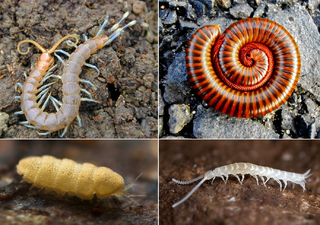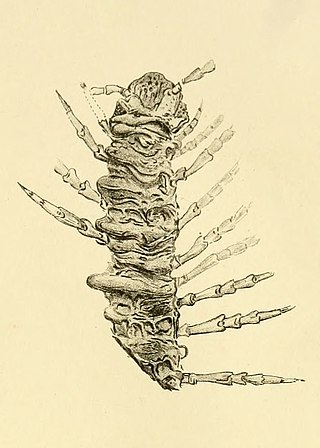Related Research Articles

The Devonian is a geologic period and system of the Paleozoic era, spanning 60.3 million years from the end of the Silurian, 419.2 million years ago (Ma), to the beginning of the Carboniferous, 358.9 Ma. It is named after Devon, England, where rocks from this period were first studied.

The Silurian is a geologic period and system spanning 24.6 million years from the end of the Ordovician Period, at 443.8 million years ago (Mya), to the beginning of the Devonian Period, 419.2 Mya. The Silurian is the shortest period of the Paleozoic Era. As with other geologic periods, the rock beds that define the period's start and end are well identified, but the exact dates are uncertain by a few million years. The base of the Silurian is set at a series of major Ordovician–Silurian extinction events when up to 60% of marine genera were wiped out.

The subphylum Chelicerata constitutes one of the major subdivisions of the phylum Arthropoda. It contains the sea spiders, horseshoe crabs, and arachnids, as well as a number of extinct lineages, such as the eurypterids and chasmataspidids.

Millipedes are a group of arthropods that are characterised by having two pairs of jointed legs on most body segments; they are known scientifically as the class Diplopoda, the name derived from this feature. Each double-legged segment is a result of two single segments fused together. Most millipedes have very elongated cylindrical or flattened bodies with more than 20 segments, while pill millipedes are shorter and can roll into a tight ball. Although the name "millipede" derives from Latin for "thousand feet", no species was known to have 1,000 or more until the discovery in 2020 of Eumillipes persephone, which can have over 1,300 legs. There are approximately 12,000 named species classified into 16 orders and around 140 families, making Diplopoda the largest class of myriapods, an arthropod group which also includes centipedes and other multi-legged creatures.

Stonehaven is a town in Scotland. It lies on Scotland's northeast coast and had a population of 11,602 at the 2011 Census. After the demise of the town of Kincardine, which was gradually abandoned after the destruction of its royal castle in the Wars of Independence, the Scottish Parliament made Stonehaven the successor county town of Kincardineshire. It is currently administered as part of the Aberdeenshire Council Area. Stonehaven had grown around an Iron Age fishing village, now the "Auld Toon", and expanded inland from the seaside. As late as the 16th century, old maps indicate the town was called Stonehyve, Stonehive, Timothy Pont also adding the alternative Duniness. It is known informally to locals as Stoney.

Myriapods are the members of subphylum Myriapoda, containing arthropods such as millipedes and centipedes. The group contains about 13,000 species, all of them terrestrial.

Eurypterus is an extinct genus of eurypterid, a group of organisms commonly called "sea scorpions". The genus lived during the Silurian period, from around 432 to 418 million years ago. Eurypterus is by far the most well-studied and well-known eurypterid. Eurypterus fossil specimens probably represent more than 95% of all known eurypterid specimens.

Arthropleuridea is an extinct subclass of myriapod arthropods that flourished during the Carboniferous period, having first arose during the Silurian, and perishing in the Early Permian. Members are characterized by possessing diplosegement paranotal tergal lobes separated from the body axis by a suture, and by sclerotized plates buttressing the leg insertions. Despite their unique features, recent phylogenetic research suggests Arthropleuridea be included among millipedes in the class Diplopoda. The subclass contains three recognized orders, each with a single genus.

Hylonomus is an extinct genus of reptile that lived 312 million years ago during the Late Carboniferous period. It is the earliest unquestionable reptile. The only species is the type species Hylonomus lyelli. Despite being amongst the oldest known reptiles, it is not the most primitive member of group, being a eureptile more derived than either parareptiles or captorhinids.

Hibbertopterus is a genus of eurypterid, a group of extinct aquatic arthropods. Fossils of Hibbertopterus have been discovered in deposits ranging from the Devonian period in Belgium, Scotland and the United States to the Carboniferous period in Scotland, Ireland, the Czech Republic and South Africa. The type species, H. scouleri, was first named as a species of the significantly different Eurypterus by Samuel Hibbert in 1836. The generic name Hibbertopterus, coined more than a century later, combines his name and the Greek word πτερόν (pteron) meaning "wing".

Arthropleura is a genus of extinct millipede arthropods that lived in what is now North America and Europe around 345 to 290 million years ago, from the Viséan stage of the lower Carboniferous Period to the Sakmarian stage of the lower Permian Period. The species of the genus are the largest known land invertebrates of all time, and would have had few, if any, predators.

Pneumodesmus newmani is a species of myriapod that lived during the late Wenlock epoch of the middle Silurian, around 428 million years ago. Although a 2017 study dates its occurrence based on zircon data analysis as the Early Devonian (Lochkovian), the 2023 study confirmed the age identification of the 2004 study through palynological, palaeobotanical and ziron analyses incorporating newly discovered additional data. It is one of the first myriapods, and among the oldest creatures to have lived on land. It was discovered in 2004, and is known from a single specimen from Stonehaven, Aberdeenshire, Scotland.

Arthropods are invertebrate animals in the phylum Arthropoda. They possess an exoskeleton with a cuticle made of chitin, often mineralised with calcium carbonate, a metamerically segmented body, and paired jointed appendages. In order to keep growing, they must go through stages of moulting, a process by which they shed their exoskeleton to reveal a new one. They are an extremely diverse group, with up to 10 million species.

The evolution of fish began about 530 million years ago during the Cambrian explosion. It was during this time that the early chordates developed the skull and the vertebral column, leading to the first craniates and vertebrates. The first fish lineages belong to the Agnatha, or jawless fish. Early examples include Haikouichthys. During the late Cambrian, eel-like jawless fish called the conodonts, and small mostly armoured fish known as ostracoderms, first appeared. Most jawless fish are now extinct; but the extant lampreys may approximate ancient pre-jawed fish. Lampreys belong to the Cyclostomata, which includes the extant hagfish, and this group may have split early on from other agnathans.

Archipolypoda is an extinct group of millipedes known from fossils in Europe and North America and containing the earliest known land animals. The Archipolypoda was erected by Scudder (1882) but redefined in 2005 with the description of several new species from Scotland. Distinguishing characteristics include relatively large eyes with densely packed ocelli, and modified leg pairs on the 8th body ring. Some species had prominent spines while others had a flattened appearance.

The Cowie Formation is geological formation located on the Highland Boundary Fault between the fishing village of Cowie and Ruthery Head, in Aberdeenshire, Scotland. Age of this formation is controversial, that was originally estimated at the Middle Silurian, Wenlock to Ludlow, but zircon geochronology shows the Early Devonian, Lochkovian instead. In study published in 2023, according to spore microfossils and additional zircon data, the Middle Silurian, late Wenlock age is suggested again. This formation preserves fossils, including a millipedes such as Pneumodesmus and Cowiedesmus that were discovered by Mike Newman in 2001, and some agnathan like Cowielepis.

Cowielepis is an extinct genus of jawless fish in the class Anaspida. It is from the Cowie Harbour fish bed of Stonehaven, Scotland, which age was originally considered as the Silurian, one study reassigned to Early Devonian (Lochkovian), and 2023 study suggested Wenlock age again.

This timeline of eurypterid research is a chronologically ordered list of important fossil discoveries, controversies of interpretation, and taxonomic revisions of eurypterids, a group of extinct aquatic arthropods closely related to modern arachnids and horseshoe crabs that lived during the Paleozoic Era.

Kampecaris is an extinct genus comprising the Kampecarida, an enigmatic group of millipede-like arthropods, from the Silurian and early Devonian periods of Scotland and England. They are among the oldest known land-dwelling animals. They were small, short-bodied animals with three recognizable sections: an oval head divided along the midline, ten limb-bearing segments forming a cylindrical trunk that tapered slightly towards the front, and a characteristic swollen tail formed by a modified segment that tapers at its rear into an "anal segment". The cuticle forming their exoskeletons was thick, heavily calcified, and composed of two layers.

Coalbrookdale Formation, earlier known as Wenlock Shale or Wenlock Shale Formation and also referred to as Herefordshire Lagerstätte in palaeontology, is a fossil-rich deposit (Konservat-Lagerstätte) in Powys and Herefordshire at the England–Wales border in UK. It belongs to the Wenlock Series of the Silurian Period within the Homerian Age. It is known for its well-preserved fossils of various invertebrate animals many of which are in their three-dimensional structures. Some of the fossils are regarded as earliest evidences and evolutionary origin of some of the major groups of modern animals.
References
- 1 2 3 Wilson, Heather M.; Anderson, Lyall I. (2004). "Morphology and taxonomy of Paleozoic millipedes (Diplopoda: Chilognatha: Archipolypoda) from Scotland". Journal of Paleontology. 78 (1): 169–184. doi:10.1666/0022-3360(2004)078<0169:MATOPM>2.0.CO;2.
- ↑ Russell Garwood & Gregory Edgecombe (2011). "Early terrestrial animals, evolution and uncertainty". Evolution: Education and Outreach . 4 (3): 489–501. doi: 10.1007/s12052-011-0357-y .
- ↑ Suarez, Stephanie E.; Brookfield, Michael E.; Catlos, Elizabeth J.; Stöckli, Daniel F. (28 June 2017). "A U-Pb zircon age constraint on the oldest-recorded air-breathing land animal". PLOS ONE. 12 (6): e0179262. doi: 10.1371/journal.pone.0179262 . ISSN 1932-6203. PMC 5489152 . PMID 28658320.
- ↑ Wellman, C.H.; Lopes, G.; McKellar, Z.; Hartley, A. (2023). "Age of the basal 'Lower Old Red Sandstone' Stonehaven Group of Scotland: The oldest reported air-breathing land animal is Silurian (late Wenlock) in age". Journal of the Geological Society. The Geological Society of London. doi:10.1144/jgs2023-138. ISSN 0016-7649.